29th Sep 2021
GOVT REDUCES PATENT FEES FOR EDUCATIONAL INSTITUTIONS BY 80 PERCENT
The Central Government introduced Patents (Amendment) Rules, 2021 to reduce the fee for patent filing and prosecution for educational institutions by 80 percent.
Highlights:
- The move aims to strengthen innovation and creativity in the knowledge economy.
- While applying for patents, innovators had to apply for these in the name of institutions that were required to pay exorbitant patenting fees.
- High patenting fee was a hindrance for educational institutions in getting newer research and technologies patented. It worked as a disincentive for the development of newer technologies.
- Hence, the official fees payable in reference to the Patents Rules, 2003 have been reduced through the Patents (Amendment) Rules, 2021.
Key initiatives by the government:

- The government has also amended the patent rules in 2016, 2017, 2019 and 2020 to remove procedural inconsistencies and unnecessary steps in the processing of patent applications.
- These have helped expedite the grant, registration and final disposal process, and make these more efficient, user-friendly, and compatible for e-transactions.
- The initiatives include:
- Augmentation of manpower by recruiting new examiners
- Making the patenting process completely online
- Hearing of patenting cases through video-conferencing for speedy and contact-less proceedings
- Dynamic redesigning of the website and real-time based hassle-free dissemination of IP information to stakeholders.
- Mechanism of lodging feedback and complaints regarding the functioning of IP offices has been set up on the IPO website.
- Expedited Examination System has been introduced where an application for grant of patent is decided within one year of filing.
- The time for final disposal of patents, has been reduced to an average of 48 months.
- It will be reduced further to an average of 24-30 months by the end of 2021.
- The Department for Promotion of Industry and Internal Trade is working to promote greater collaboration between industry and academia.
- The Controller General of Patents, Designs & Trade Marks (CGPDTM) is engaged in the dissemination of information to IP stakeholders through awareness activities in IPR conducted for schools, universities, enforcement agencies, and other stakeholders.
CENTRE NOTIFIES SCHEME FOR PROMOTION OF 'MEDICAL DEVICE PARKS'
The Government of India has launched the “Promotion of Medical Device Parks" scheme to support the medical devices industry to reach its potential.
Objectives:
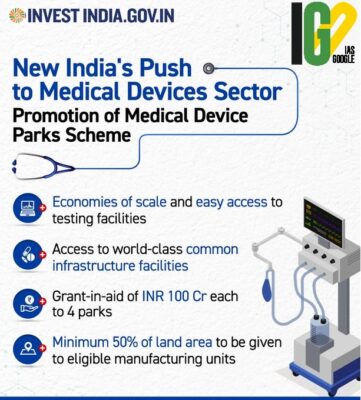
- Easy access to standard testing and infrastructure facilities.
- Creation of world class common infrastructure facilities for increased competitiveness.
- Reduction in the cost of production of medical devices leading to better availability and affordability in the domestic market.
- Reaping the benefits arising due to optimization of resources and economies of scale.
Highlights:
- Initiative of: Ministry of Chemicals and Fertilizers
- 16 States and Union Territories were received under the scheme. The selection of the states and union territories (UTs) is based on the challenge method based on the parameters such as:
- Utility charges, State policy incentives, total area of the park, land lease rate, connectivity of the park, ease of doing business ranking, availability of technical manpower etc.
- The Government of Himachal Pradesh, Tamil Nadu, Madhya Pradesh, and Uttar Pradesh have given "in-principle" approval under the scheme.
- The total financial outlay of the scheme is Rs 400 crores and the tenure is from FY 2020-2021 to FY 2024-2025.
- The financial assistance to a selected Medical Device Park would be 70% of the project cost having infrastructure facilities.
- In the North-Eastern and the Hilly States, the assistance would be 90% of the project cost.
- Maximum assistance for one Medical Device Park would be limited to Rs 100 crores.
- The Parks will provide common infrastructure facilities at one place, creating a robust ecosystem for the medical device manufacturing and reducing the cost significantly.
AROUND 66% CHILDREN BELOW 2 YEARS DON'T GET NUTRITIOUS DIET: UNICEF
A Child Nutrition Report 2021 was released by United Nations Children's Fund (UNICEF) recently.
Highlights:
- As per the report, two in every three children between six months and two years did not get the nutritious diet needed for healthy growth.
- Around 27% of children aged six-eight months were not fed any solid food.
- Among children aged 6–23 months, around half were not fed the minimum number of meals or snacks.
- The diet of the world’s children below the age of two years has not improved in the last decade, and continues to get inadequate nutrients.
- The quality of children’s diets varies widely among regions.
- As many as 62% of children aged 6–23 months in Latin America and the Caribbean were fed a minimally diverse diet in 2020.
- In South Asia and two sub-Saharan African regions, the share was less than 25%.
- Children in rural areas, poorer households and disadvantaged regions within countries have the least diverse diets.
- Around one in every three young children in Australia, Ethiopia, Ghana, India, Mexico, Nigeria, Serbia and Sudan were fed at least one processed or ultra-processed food or drink daily.
About the report:
- The report is a flagship report of United Nations Children's Fund.
- It examined the latest data and evidence on the status, trends and inequities in the diets of children aged 6–23 months and barriers to nutritious diets.
- The analysis used data from the UNICEF Global Database on Infant and Young Child Feeding.
- The repository collated data from 607 nationally representative surveys conducted in 135 countries and territories, representing more than 90% of all children under 2 years of age globally.
Key Recommendations:
To deliver a nutritious, safe and affordable diet to every child, the report recommended the following actions:
- Increasing the availability and affordability of nutritious foods. Design social transfers – cash, food and/or vouchers – that support nutritious and safe diets in early childhood.
- Implementing national standards and legislation to protect young children from unhealthy processed food and drink. Ending harmful marketing practices targeting children and families.
- Position young children’s right to nutritious and safe diets as a priority in the national development agenda and ensure coherent policy support and legislation.
- Expand caregiver access to quality counselling and support on young child feeding by investing in the recruitment, training, supervision and motivation of community-based counsellors and health workers.
Concerns:
- Policies and programmes to improve young children’s diets are not prioritised and are being further eroded by the COVID-19 pandemic.
- Nearly 83% countries reported considerable disruptions in the coverage of services to promote nutritious and safe diets for young children at the peak of the first wave of the pandemic in April 2020.
- No country has a comprehensive set of policies, legal measures and programmes to improve young children’s diets.
ONLY A THIRD OF SEWAGE GENERATED PER DAY IN INDIA TREATED, REPORTS CPCB
According to the latest report of the Central Pollution Control Board, sewage treatment plants in India can treat a little more than a third of the sewage generated per day.
- The report is based on the information received from the state pollution control boards.
- The data has been carried out with respect to installed capacity, operational capacity, and actual utilization.
Highlights:
- India generated 72,368 million liters per day (MLD) whereas the installed capacity of sewage treatment plants (STP) was 31,841 MLD.
- Out of total 72,368 MLD sewage generated every day, only 20,235 MLD is treated.
- In terms of proportion of sewage waste treated to generated ratio the states and UTs are performing well.
- Delhi (72%)
- Punjab (72%)
- Haryana (71%)
- Gujarat (54%)
- Maharashtra (47%)
- Arunachal Pradesh, Bihar, Assam, Chhattisgarh, Jharkhand, Kerala, utilise 0-1% of sewage.
- West Bengal, Odisha and Jammu and Kashmir treat 2-7% of sewage.
Skewed Distribution:
- Maharashtra, Gujarat, Uttar Pradesh, Delhi, and Karnataka, account for 60% of the total installed treatment capacity of the country.
- Madhya Pradesh, Haryana, Punjab, Tamil Nadu, and Rajasthan, alone constitute 86% of the total installed capacity.
- Bihar has a small installed capacity of STPs. But on the operational front, they score a zero.
- Assam generates 809 MLD of sewage, it does not have a single operational STP. Septic tanks are used in the state.
- Chandigarh ranks first in terms of total sewage generated to what is treated.
- It generates 188 MLD of sewage and has an operational capacity to treat 271 MLD.
Reuse of Sewage:
- Treated sewage water can be reused for horticulture, irrigation, washing activities, fire-fighting, industrial cooling, and gardening.
- The proportion of the reuse of treated sewage is maximum in Haryana (80%).
- followed by Puducherry (55%), Delhi (50%), Chandigarh (35%), Tamil Nadu (25%), Madhya Pradesh (20%) and Andhra Pradesh (5%).
- The reuse of treated sewage can reduce the demand of water from aquatic sources like rivers, ponds, lakes, and groundwater sources.
- Less consumption of raw water will help in conserving natural water resources.
CHINA WORST ABUSER OF INTERNET FREEDOM; PAKISTAN IN TOP 10: REPORT
The “Freedom on the Net 2021: The Global Drive to Control Big Tech" report was released by the U.S.-based Freedom House recently.
- As per the report the Internet freedom has declined for the 11th year in a row worldwide.
About the report:
- The report has measured the level of internet freedom for 70 countries and assigns them numerical scores ranging from 100 (the freest nation) to zero (the least free).
- Countries with scores between 70 to 100 are designated as ‘Free’ on internet freedom status.
- Those with points between 40 to 69 are designated as ‘Partly-free’.
- Those scoring less than 39 are designated as ‘Not free’.
- The report determines the level of internet freedom by examining three broad categories: obstacles to access; limits on content; and violations of user rights.
- The countries are categories based on nine key Internet controls to document how governments censor and control the digital space.
- The controls include blocking of social media, deliberate disruption of communication network, manipulation of online discussions by pro-government commentators, and introduction of a new law increasing surveillance and restricting anonymity.
Highlights:
- India has scored 49 points in the report. China was ranked as the worst environment for Internet freedom for the seventh year in a row.
- The greatest deteriorations were found in Myanmar, Belarus, and Uganda, where state forces cracked down amid electoral and constitutional crises.
- Authorities in at least 45 countries, including India, are suspected to have access to targeted spyware and extraction technology purchased from private companies.
- Governments in least 48 countries surveyed pursued new rules for tech companies on content, data, and competition in the past year, attempting to suppress online dissent.
- In fact, India ranks among 55 other countries that have investigated, arrested, or convicted people for their social media posts, especially on WhatsApp, Facebook, YouTube and Twitter.
Ranks of the countries:
The top 10 countries with the highest level of internet freedom:
- Iceland
|
- Estonia
|
- Canada
|
- Costa Rica
|
- Taiwan
|
- Germany
|
- France
|
- UK
|
- Georgia
|
- Japan
|
|
|
The lowest rankers:
Scores in Asia-Pacific:
Internet freedom:
- Internet freedom is a term that includes digital rights, freedom of information, and the right to Internet access.
- Suppression of Internet freedom indicates that governments across the world are asserting their authority over technology platforms, forcing business to comply with censorship and surveillance.
₹22,000 CRORE DEAL WITH AIRBUS FOR 56 C-295 TRANSPORT PLANES
Ministry of Defence has signed an estimated ₹22,000-crore deal with Airbus Defence and Space S.A., Spain for 56 C-295MW transport aircraft.
Highlights:

- The aircraft will replace the Indian Air Force’s ageing 56 Avro aircraft that were procured in the 1960s.
- Of the 56 aircraft, 16 will be delivered in flyaway condition from Spain within 48 months and the remaining will be manufactured in India by the Tata Group within 10 years from the date of contract.
- This is the first project of its kind in which a military aircraft will be manufactured in India under technology transfer by the private sector.
Aircraft:
- The C295 has 5-10 tonne capacity. It is used for tactical transport of up to 71 troops or 50 paratroopers, and for logistic operations to locations not accessible to current heavier aircraft.
- It has a proven capability of operating from short or unprepared airstrips.
Significance:
- The aircraft will give a major boost to the tactical airlift capability of the IAF, especially in the northern and north-eastern sectors and the Andaman and Nicobar Islands.
- The manufacturing in India will create 15,000 direct jobs and 10,000 indirect jobs over the coming 10 years.
PUNJAB CM CHARANJIT SINGH CHANNI’S SEAT CHAMKAUR SAHIB: SIKH HISTORY, CURRENT POLITICS
The newly elected Chief Minister of Punjab represents the Assembly constituency of Chamkaur Sahib, in Punjab which is of significance in Sikh history as well as contemporary politics.
Chamkaur Sahib:

- At this place, Guru Gobind Singh lost two of his elder sons in the Battle of Chamkaur.
- The Battle of Chamkaur was fought between the Khalsa, led by Guru Gobind Singh, against the coalition forces of Mughal army and Ajmer Chand's league of Rajput Hill Chieftains.
- The period of this battle is 21,22 and 23 December 1704.
- Guru Gobind Singh gave an account of the battle in Zafarnama, his letter to Aurangzeb.
Genesis:
- May 1704: The coalition forces led by Wazir Khan, the Nawab of Sirhind, had laid siege to Anandpur Sahib in the hope of capturing Guru Gobind Singh.
- December 1704: After seven months of fighting and heavy losses, the coalition forces offered a safe passage to the Guru and his followers.
- The heads of the coalition pledged they would not harm the Guru, his family, or his soldiers, with a peace treaty sent in the name of Emperor Aurangzeb.
- But when Gobind Singh and his followers stepped out of Anandpur Sahib fort on the night of December 20, they were attacked. They fled towards Ropar and the swollen Sarsa river.
The Battle:
- The Guru, accompanied by panj piaras, his elder sons Ajit Singh (18) and Jujhar Singh (14), and around 40 soldiers, regrouped in a fortress-like two-storey house.
- They were surrounded by an army commandeered by Wazir Khan and Sher Mohammed Khan, the younger brother of Malerkotla’s chieftain.
- The Guru sent out soldiers in small squads for hand-to-hand combat. Two such attacks were led by his sons, both of whom died fighting.
- Three of the panj piaras — Mohkam Singh, Himmat Singh and Sahib Singh — too died fighting.
- When very few soldiers were left, at the Chamkaur ki garhi (fort) on December 22 the panj piaras issued an edict (hukumnama) ordering the Guru to leave.
- This was the first edict issued by panj piaras after the formation of the Khalsa on April 13, 1699.
- Five days later, Guru Gobind Singh’s two younger sons, aged nine and seven, were bricked alive for refusing to convert to Islam.
- Every year, a shaheedi jor mela, marked by prayers and langar, is held to commemorate the martyrdom of Guru Gobind Singh’s young sons and his soldiers.
WHAT SAMPLES BROUGHT BACK BY CHINA MISSION TELL US ABOUT MOON
China’s Chang’e-5 lunar mission delivered to Earth nearly 2 kg of rocky fragments and dust from the Moon on December 16, 2020.
Highlights:
- Chang’e-5 landed on an area of the Moon which is not sampled by the American or Soviet missions.
- It retrieved fragments of the youngest lunar rocks for analysis in laboratories on Earth.
The Findings:
- 90% of the materials collected by Chang’e-5 from the landing site and its surroundings, are ‘mare basalts’.
- These volcanic rocks are visible to us as the darker grey areas that spilled over the Moon as ancient eruptions of lava.
- 10% percent of the fragments have different, ‘exotic’ chemical compositions.
Importance:
- The distinct 10% fragments may preserve records of other parts of the lunar surface and types of space rocks that have impacted the Moon’s surface.
- Glassy droplets have been traced, known as ‘Rima Mairan’ and ‘Rima Sharp’.
- The fragments could give insights about the energetic, fountain-like volcanic activity on the Moon.
- The geological age of the rocks at the landing site ages less than 2 billion years.
CSIR-CMERI SOLAR DC COOKING SYSTEM- A STEP TOWARDS A GREEN & POLLUTION FREE INDIA
CSIR-CMERI has handed over the “CSIR-CMERI developed Solar DC Cooking System” to Asansol Braille Academy in West Bengal on September 22, 2021.
CSIR-CMERI Solar DC Cooking System:
- It is a “Solar Energy based Cooking System”, comprises of solar PV panel, battery bank, charge controller and cooking oven.
- It provides a Clean Cooking Environment, uniform heating, and Invertor-Less Direct Operation.
- It has a potential to save 1 ton Carbon Dioxide emissions per year per household.
- It has 20-25% better efficiency and more Economical as compared to the Conventional Solar based Cooking Systems.
Significance:
- The system will help in curbing the Carbon Dioxide emissions.
- Widespread usage of the System will play a crucial role in achieving the target of 200 GW of Solar energy.
Central Mechanical Engineering Research Institute (CSIR-CMERI):
- It is a public engineering research and development institution located in Durgapur, West Bengal.
- It is a constituent laboratory of Indian Council of Scientific and Industrial Research (CSIR).
- Established: February 1958
Aim: To develop engineering technology, to help Indian industries.
KVIC SETS UP TUSSAR SILK YARN PRODUCTION CENTRE IN ODISHA TO BOOST LOCAL INDUSTRY, CREATE EMPLOYMENT
Khadi and Village Industries Commission (KVIC) will set up Odisha’s first ever Tussar Silk Yarn Production Centre at Choudwar in Cuttack district.
- This silk yarn production centre will ensure local availability of Tussar Silk yarn, create local employment and reduce the silk production cost.
Tussar silk:
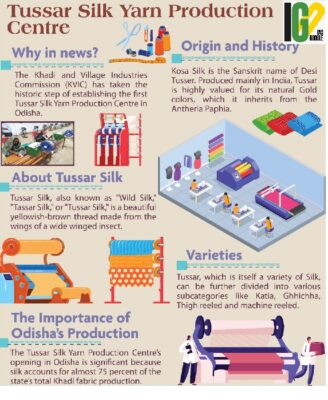
- Tussar silk is one of the finest varieties of Silk distinguished by its coarseness and porous weave that give it a rugged and rustic appearance.
- It is produced from larvae of several species of silkworms belonging to the moth genus Antheraea. These silkworms live in the wild forests in trees belonging to Terminalia species, Sal, jamun and oak tree found in South Asia.
- The silk is valued for its rich texture and natural, deep-gold colour. Various varieties are produced in countries including China, India, Japan, and Sri Lanka.
- India is the second-largest producer of tussar silk, and the exclusive producer of Indian tussar (known as tropical tussar).
- Much of it is produced in Bhagalpur (called Bhagalpur silk) in Bihar, Malda district of West Bengal and in Odisha.
National Hydroelectric Power Corporation’s 510 MW Teesta-V Power Station in Sikkim has been conferred with the prestigious Blue Planet Prize by International Hydropower Association.
Highlights:
- The award was announced during the World Hydropower Congress, 2021.
- The award had been conferred to Teesta-V Power Station based on its sustainability assessment using the Hydropower Sustainability Assessment Protocol (HSAP) of IHA.
- The IHA membership includes leading hydropower owners, developers, suppliers, and consultants.
- The Blue Planet Prize is awarded to hydropower projects that demonstrate excellence in sustainable development.
- The HSAP is the leading international tool for measuring the sustainability of hydropower projects.
IGNCA TO START CULTURAL MAPPING IN 75 VILLAGES SOON
The Indira Gandhi National Centre for the Arts will start a trial run of culture mapping in 75 villages in October 2021.
Highlights:
- The Culture Ministry approved the mission in 2017 with a ₹469 crore budget.
- Currently, the mission is with Indira Gandhi National Centre for the Arts (IGNCA).
- Creating a database for folk arts and mapping of the heritage of villages would be carried out over five years.
- Volunteers from the Nehru Yuva Kendra Sanghathan, the National Service Scheme, and sociology students will collect data on the art forms and heritage of the areas from the villages.
- Approved budget: ₹89 crore
- The IGNCA would aim to complete mapping in 5,000 villages by the end of the financial year 2021-2022.
National Mission on Cultural Mapping:
- Established in 2015. The mission is a project of the Ministry of Culture, Government of India.
- Aim: To address the necessity of preserving the threads of rich Indian Art and Cultural Heritage.
Significance of the mission:
- It can create a database that is easily accessible, thus becoming a resource for the media, researchers, and funders.
- It will identify, collect, and record cultural assets and resources.
- This database can be used to preserve culture and provide or facilitate livelihoods.
Objectives:
- To address the necessity of preserving threads of rich Indian Art and Cultural Heritage.
- To convert widespread cultural canvass into an objective Cultural Mapping.
- To design a mechanism to fulfil the aspirations of the artist community of the nation.
- To preserve the rich cultural heritage of the country for future generations.
- To create a strong “cultural vibrancy” throughout the nation.
Importance:
- Fostering Cultural Awareness
- Awareness about the heritage and rich culture of the country is reducing day by day, resulting in:
- weak linkage between cultural legacy and our day-to-day life
- feeble binding force within the society.
- Cultural Preservation
- The cultural footprint of the country is narrowed down to the individual aspirations like State, language, cast urban/rural, etc.
- Many arts forms are becoming extinct because of non-existence of resources for the promotion of arts and culture.
- Sustainable Employment
- Culture & Creative Industries employs 45‐48% of the total workforce.
- Developing a revenue‐generation model which could be self-sustainable is a big challenge.
- Optimal Resource Allocation and Utilization
- There is no centralized, comprehensive cultural mapping data of the country and whatever
- The database of artistes is totally based on personal contacts.
- In the absence of data, the resource utilization is non-optimal, and the outcome is dismal.
- There is no relationship between processes for cultural development and grant allocation.
UN FOOD SYSTEMS SUMMIT 2021
The UN Food Systems Summit took place during the UN General Assembly in New York as part of the Decade of Action to achieve the Sustainable Development Goals (SDGs) by 2030.
- The Summit launched new actions to deliver progress on all 17 SDGs, each of which relies to some degree on healthier, more sustainable and equitable food systems.
Aim:
- Maximizing the co-benefits of a food systems approach across the entire 2030 Agenda and meeting the challenges of climate change.
- To provide a platform for ambitious new actions, innovative solutions, and plans to transform food systems and leverage these shifts to deliver progress across all of the SDGs.
Objectives:
- Raise awareness of food systems' centrality to the entire sustainable development agenda, and the urgency of transforming food systems, particularly in the wake of a global pandemic;
- Align stakeholders around a common understanding and narrative of a food system framework as a foundation for concerted action, making food and food systems a more widespread issue for advocacy and action to achieve the 2030 Agenda;
- Recognize the need for inclusivity and innovation in food systems governance and action;
- Motivate and empower stakeholders who support food systems transformation through the development of improved tools, measurement, and analysis; and
- Catalyze, accelerate, and enlarge bold action for the transformation of food systems by all communities, including countries, cities, companies, civil society, citizens, and food producers.
Outcomes:
- There is a need to achieve the United Nations-mandated Sustainable Development Goals (SDG) by 2030 and address climate change in view of food production.
- There is an urgent need to move from incremental and siloed action towards a systems approach.
- All stakeholders and people within the system play a crucial role through responsible and innovative practices in ensuring that everyone has access to healthy food.
- Food systems encompass the entire range of actors and their interlinked value-adding activities involved in the production, aggregation, processing, distribution, consumption and disposal of food products.
- Food systems comprise all food products that originate from crop and livestock production, forestry, fisheries and aquaculture, as well as the broader economic, societal and natural environments in which these diverse production systems are embedded.
- The UN secretary-general commended the summit for “injecting new life into multilateralism” and for “leading the way to food systems that can drive the global recovery in three fundamental ways: For people, for the planet, and for prosperity.”
- Five action areas to help inform the transitions needed to realise the vision of the 2030 agenda:
- Nourish all people
- Boost nature-based solutions
- Advance equitable livelihoods, decent work and empowered communities
- Build resilience to vulnerabilities, shocks and stresses
- Support means of implementation
- At a global level, UN agencies as the FAO, the International Fund for Agricultural Development (IFAD), and the World Food Programme (WFP) will jointly lead a UN system-wide coordination hub to continue the work of the Summit.
- To track progress toward the UN’s 2030 Agenda, the secretary-general will present an annual report to the high-level political forum.
PROPORTION OF ALL CANCER CASES HIGHER IN MEN: ICMR REPORT
The Indian Council of Medical Research’s (ICMR) ‘Clinicopathological Profile of Cancers in India: A Report of the Hospital Based Cancer Registries, 2021’ has been released.
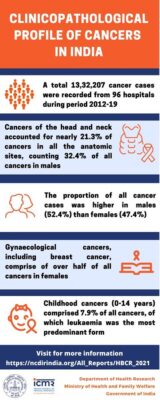
- The proportion of all cancer cases was higher in males (52.4%) than females (47.4%) with gynaecological cancers, including breast cancer, comprising over half of all cancers in females.
- Childhood (0-14 years) cancers constitute 7.9% of all cancers.
- Cancers of the head and neck region accounted for nearly one third (31.2%) of the cancers among males.
- The highest proportion of cancer from all sites was reported in the 45 to 64 years age group, except for prostate cancer in males, which was higher in those over 65 years.
- Cancers in sites associated with tobacco use comprised 48.7% of cancers among males and 16.5% among females.
- The relative proportion of site-specific cancers was higher in males than females, except for thyroid cancer (2.5% in females versus 1% in males) and gallbladder cancer (3.7% in females versus 2.2 % in males).
- Over one-third of patients with cancers of the tongue, larynx, thyroid, corpus uteri, kidney (including children), bladder and retinoblastoma had localised disease.
- Chemotherapy was the most typical treatment modality for many cancers regardless of the clinical extent of disease at presentation, including cancers of the liver, gallbladder, stomach, lung and childhood cancers and regardless of the organ site and clinical extent, most cancer patients, were initiated on cancer-directed treatment within 8 to 30 days of diagnosis.
- Over half the patients with cancer of the brain and nervous system, and about one-third of the patients of lung, prostate, bladder and thyroid cancer with localised disease diagnosed at the reporting institution, were initiated on cancer directed treatment on the same day.
Cancer:
- Cancer is a disease in which some of the body’s cells grow uncontrollably and spread to other parts of the body.
- Cancer can start almost anywhere in the human body, which is made up of trillions of cells.
- Normally, human cells grow and multiply (through a process called cell division) to form new cells as the body needs them. When cells grow old or become damaged, they die, and new cells take their place.
- Sometimes this orderly process breaks down, and abnormal or damaged cells grow and multiply when they shouldn’t.
- These cells may form tumors, which are lumps of tissue. Tumors can be cancerous or not cancerous (benign). Cancerous tumors may also be called malignant tumors.
- Many cancers form solid tumors, but cancers of the blood, such as leukemias, generally do not.
Prevention and Control of Cancer, Diabetes, Cardiovascular Diseases and Stroke:
- Considering the rising burden of Non-Communicable Diseases (NCDs) and common risk factors to major Chronic NCDs, Government of India initiated an integrated National Programme for Prevention and Control of Cancers, Diabetes, Cardiovascular Diseases and Stroke (NPCDCS) under the National Health Mission.
- It links ongoing interventions of NHM such as National Tobacco Control Programme (NTCP), National Mental health Programme and National Programme for Health Care of Elderly (NPHCE) for NCDs
- It also convergence with programmes dealing with communicable diseases like TB, RCH, and Adolescent/School Health etc.
Aim:
- Optimization of scarce resources and provision of seamless services
- Operating through NCD cells constituted at State and District level
Objectives:
- Health promotion through involvement of community, civil society, organizations, media etc.
- Population based and opportunistic screening at all levels from sub-centre and above for early detection of diabetes, hypertension and common cancers
- To prevent and control chronic NCDs (common Cancer, Diabetes and Hypertension)
- Capacity building for prevention, early diagnosis, treatment, rehabilitation, IEC/BCC and operational research
- Diagnosis and cost-effective treatment at all three levels of healthcare
- Development of database of NCDs through Surveillance System
- NCD morbidity, mortality and risk factors monitoring
Funding:
- To States under NCD Flexi-Pool through State PIPs, with Centre to State ratio of 60:40
- For North-Eastern and Hilly States, share is 90:10
Health facility under NPCDCS:
- Sub centre
- Primary healthcare (PHC)
- Community Health Centres / First Referral Units (CHC/FRU)
- District Hospital
- Medical College
- Tertiary Cancer Centre
Non-Communicable Diseases (NCDs)?
- A non-communicable disease (NCD) is a disease that is not transmissible directly from one person to another.
- NCDs include Parkinson's disease, autoimmune diseases, strokes, most heart diseases, most cancers, diabetes, chronic kidney disease, osteoarthritis, osteoporosis, Alzheimer's disease, cataracts, and others.
- They are long duration diseases and generally slow in progression.
- They are result of a combination of genetic, physiological, environmental and behavior factors.
ONE THIRD OF GLOBAL CROPLAND WILL BE DROUGHT-HIT BY 2040 IF EMISSIONS DON’T STOP: REPORT
According to a report by Chatham House, the average proportion of global cropland affected by drought will likely rise by a third by 2040 if global greenhouse gas emissions continue to increase.
- The Institute published Climate change risk assessment 2021 ahead of the UN Climate Change Conference (CoP 26), Glasgow, in November 2021.
Highlights:

- Agriculture will need to produce nearly 50% more food by 2050 to feed a growing global population.
- The United States, China, Brazil, and Argentina, which grow 87% of the world’s maize, could suffer a steep drop in their maize production by 2040.
- There is a 50% chance of synchronous crop failure, the failure of a single crop in multiple regions simultaneously.
- By 2050, global cropland areas will be impacted by reductions in crop duration periods of at least 10 days exceeding 60% for winter wheat, 40% for spring wheat, and 30% for rice.
- 700 million people each year will likely be exposed to prolonged severe droughts of at least six months by 2040.
- North Africa, West Asia, western and central Europe, and Central America will see more than 10% of their populations impacted by severe drought.
- East and South Asia will be hard hit, with 230 million people subjected to drought.
- Outside Asia, Africa will likely have the greatest number of people facing drought, exceeding 180 million by 2050.
- The governments of highly emitting countries should accelerate emissions reductions through ambitious revisions of their Nationally Determined Contributions (NDCs).
- It will lead to cheaper energy and avert the worst climate impacts.
- Paris Agreement signatories must meet their NDCs. If they fail to do so, the probability of extreme temperature increases is non-negligible.
- If emissions follow the trajectory of NDCs, there is a less than 5% chance of keeping temperatures below 2°C relative to pre-industrial levels.
- Focus should be on net-zero pledges; the implicit assumption of these targets will avert climate change.
- Unless NDCs are dramatically increased, the impacts are likely to be locked in by 2040
THE SOCIAL LIFE OF A VAMPIRE BAT
Researchers attached small devices to 50 vampire bats to track the social life and foraging habits in Panama.
Highlights:
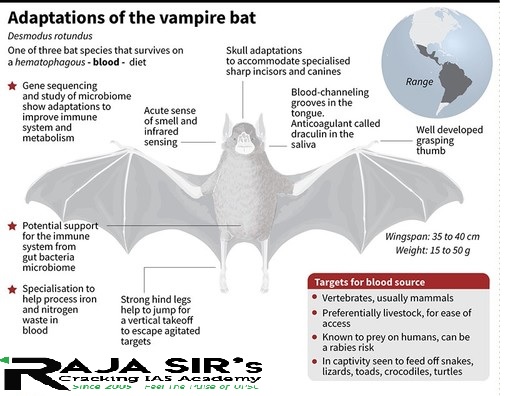
- Each bat maintains its network of close cooperative social bonds.
- The social bonds formed in roosts extended into the hunt.
- They are the only mammals with a blood-only diet.
- They have heat sensors in their snouts that help them find a spot to make a bite.
Key Facts:
- Vampire bats live in dark places in colonies, such as caves, old wells, hollow trees, and buildings.
- These creatures are nocturnal and most active in the early night.
- They roost alone, in small groups, or colonies of thousands.
- Female vampire bats form associations with one another that can last for many years.
- These small mammals drink the blood of other animals for survival.
- They feed on blood from sleeping cows, pigs, horses, and birds.
- Their bites can cause nasty infections and disease.
- They have strong hind legs and a unique thumb that helps them take off after feeding.
BLUE FOODS HAVE POTENTIAL TO BECOME MORE SUSTAINABLE: RESEARCH
A report titled “Environmental performance of blue foods” was published as part of the Blue Food Assessment (BFA).
- The BFA is a collaboration between Sweden-based Stockholm Resilience Centre, United States-based Stanford University and the non-profit EAT.
Highlights:
- The authors analysed reporting data from more than 1,690 fish farms and 1,000 unique fishery records worldwide.
- As per the report, aquatic or blue foods can be made more environmentally sustainable than they are now.
- Seaweeds and farmed bivalves, such as mussels and oysters, generated the fewest greenhouse gas and nutrient emissions and used the least land and water.
- Capture fisheries also resulted in few nutrient emissions and use limited land and water.
- Capture fisheries refers to all kinds of harvesting of naturally occurring living resources in both marine and freshwater environments.
- Capture fisheries had the potential to reduce greenhouse gas emissions through improved management and optimising gear types.
- The greenhouse gas emissions in such fisheries ranged from relatively low, such as for sardines and cod, to relatively high for flatfish and lobsters, compared to farmed fish.
- Many subsectors among blue foods such as carp and milkfish had the potential to improve their environmental performance through improved farm management, reduced feed conversion ratios and innovative technological interventions.
Blue foods and its significance:
- Blue food is the food derived from aquatic animals, plants or algae that are caught or cultivated in freshwater and marine environments.
- They can help end malnutrition, build nature-positive resilient food systems and be a part of the climate solution.
- It is a critical element to meet the UN Food Systems Summit vision to “launch bold new actions, solutions and strategies” to deliver progress on Sustainable Development Goals.
- They can make key contributions to diet-related health challenges – by reducing micronutrient deficiencies, improving heart, brain and eye health, and replacing consumption of less healthy red and processed meats.
- They can contribute to community resilience, good jobs, gender equity, and poverty alleviation.
PRIME MINISTER’S PARTICIPATION IN THE QUAD LEADERS’ SUMMIT
The first in-person Quad leaders’ summit was conducted on 24 September 2021 in the United States.
- The Quadrilateral Security Dialogue (Quad) is a strategic dialogue between the United States, India, Japan and Australia.
Highlights:
- Quad called for rule of law, freedom of navigation and overflight, peaceful resolution of disputes, democratic values and territorial integrity of states.
- The leaders vowed to ensure a “free and open” Indo-Pacific to promote free, open, rules-based order, rooted in international law and undaunted by coercion.
- It is a positive initiative designed to lift the wellbeing of the people of the Indo-Pacific, by making the region stronger, more prosperous & more stable.
- The joint statement reaffirmed that South Asia should not be used to shelter or train terrorists, or to plan future attacks.
- It called on Taliban to provide safe passage to any person wishing to leave Afghanistan, and to ensure human rights for all Afghans, including women, children, and minorities.
- Quad announced several new pacts to tackle the climate crisis and threat to cyber security.
- The countries would work together to facilitate public-private cooperation and demonstrate in 2022 the scalability and cyber security of open, standards-based technology.
- A 5G partnership was rolled out to enabling environment for 5G diversification.
- India would make 8 million doses of Johnson & Johnson Covid-19 vaccine available for export to Indo-Pacific region by the end of October 2021.
- Quad will pay for the vaccine and India will bear a certain share of those.
EXPLAINED: WHAT IS DARK ENERGY, AND HAVE SCIENTISTS FINALLY DETECTED IT?
The scientists have reported the first putative direct detection of dark energy by the XENON1T experiment.
XENON1T experiment:
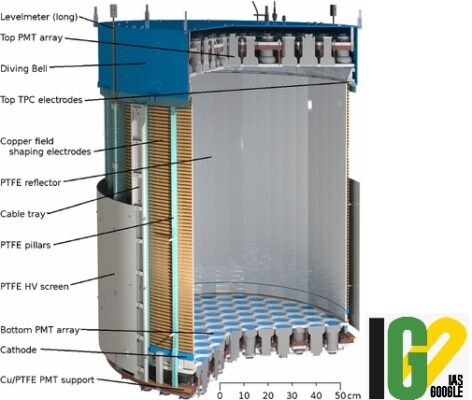
- The XENON1T experiment is the world’s most sensitive dark matter experiment. It could also be used to detect dark energy.
- It was operated deep underground at the INFN Laboratori Nazionali del Gran Sasso in Italy.
- It noticed certain unexpected results in an underground experiment, and predicted that dark energy may be responsible for it.
Dark energy Vs Dark matter:
- Everything we see – the planets, moons, massive galaxies etc.– makes up less than 5% of the universe.
- About 27% is dark matter and 68% is dark energy. While dark matter attracts and holds galaxies together, dark energy repels and causes the expansion of our universe.
Dark Energy:

- Einstein was the first person to predict dark energy.
- Roughly 68% of the universe is dark energy. It tends to accelerate the expansion of the universe.
- It is distributed evenly throughout the universe and its effect is not diluted as the universe expands.
Dark Matter:
- Dark matter makes up about 27% of the universe.
- As per the common view- dark matter is not baryonic, but made up more exotic particles like axions or WIMPS (Weakly Interacting Massive Particles).
- It is not an anti-matter because it does not produce gamma rays which are produced by the anti-matter.
- Unlike normal matter, dark matter does not interact with the electromagnetic force. This means it does not absorb, reflect or emit light, making it extremely hard to spot.
HUNARBAAZ AWARDS
The National Institute of Rural Development and Panchayati Raj presented Hunarbaaz Awards to 75 diyangjan candidates from 15 states.
Highlights:
- The awards are given to the candidates who were trained through Deen Dayal Upadhyaya Grameen Kaushalya Yojana (DDU-GKY) and Rural Self Employment Training Institutes (RSETI) schemes.
- It will expand the scope of organizations to get appropriate skilling, placement, and mentorship for youth with disabilities in rural India.
- The objective is to promote inclusivity in which youth from all sections of the society can come forward and participate in making India the skill hub of the world.
- A more sympathetic approach is needed to mainstream the needs of PWD youth.
- Robust processes must be established in which they become part of the skill ecosystem.
HIGH POWER TRANSMITTERS AT WORLD’S HIGHEST RADIO STATION AT HUMBATINGLA IN KARGIL
Ministry of Information and Broadcasting will inaugurate high power transmitters at the world’s highest radio station at Humbatingla in Kargil, UT Ladakh.
Key Points:
- Aim: To improve information reach to the public in the bordering villages of Ladakh.
- The 10kW High Power Transmitters of All India Radio, FM radio station and Doordarshan will improve the transmission and the reach in Kargil and Batalik sectors.
- People in the mountainous region would get better quality services of AIR and DD.
- Transmission of Ladakhi News and Programs on DD Kashir DTH platform will be doubled.
- It will allow viewers/listeners to learn about the country’s policies, news, and current affairs.
- It will make educational content available for the students in the region through DD and AIR.
- Prasar Bharati has been offering various educational content for school & college students in collaboration with various state education departments and institutions.
CYCLONE GULAB: HEAVY RAINS BATTER ANDHRA DISTRICTS; NO MAJOR IMPACT IN ODISHA
Cyclone Gulab made landfall in coastal regions of Andhra Pradesh and Odisha recently.
- Gulab is the second cyclone to hit Odisha in four months after Cyclone Yaas in May 2021.
- Cyclone 'Gulab' was named by Pakistan. “Gulab” refers to Rose in English.
Naming of Cyclone:

- The name Gulab is from the list of cyclone names that is maintained by the World Meteorological Organisation/United Nations Economic and Social Commission for Asia and the Pacific (WMO/ESCAP) Panel on Tropical Cyclones (PTC).
- The panel comprises 13 countries namely, India, Bangladesh, Myanmar, Pakistan, Maldives, Oman, Sri Lanka, Thailand, Iran, Qatar, Saudi Arabia, United Arab Emirates, and Yemen. They choose the names of cyclones in the region.
- The names are chosen keeping in mind they are simple to use, do not carry any inflammatory meaning, should be neutral to politics, political figures, religious beliefs, cultures, and gender.
Key Facts:
- There are six regional specialised meteorological centres (RSMCs) and five regional Tropical Cyclone Warning Centres (TCWCs) across the globe, which monitor cyclogenesis, issue advisories and name cyclones.
THE PRESTIGIOUS SHANTI SWARUP BHATNAGAR PRIZE FOR SCIENCE AND TECHNOLOGY (2021) HAS BEEN ANNOUNCED.
- Jeemon Panniyammakal, of Achutha Menon Centre for Health Science Studies (AMCHSS), Sree Chitra Tirunal Institute for Medical Sciences and Technology (SCTIMST) won the award in the discipline of medical sciences.
About the award:
- It is awarded to scientists annually for outstanding research work, applied or fundamental.
- It is instituted by the Council of Scientific & Industrial Research (CSIR) India, in the name of its late founder-director Dr (Sir) Shanti Swarup Bhatnagar.
- It carries a cash award of ₹ five lakhs.
- Age of the nominee ought to not be more than 45 years as on 31 December 2020.
AIRSPACE MAP FOR DRONE OPERATIONS RELEASED: KNOW WHERE ALL YOU CAN FLY THEM
The Aviation Ministry released India’s airspace map for drone operations which clearly demarcates where all can drones be flown (green zone), not flown (red list) or flown with previous clearance (yellow zone).
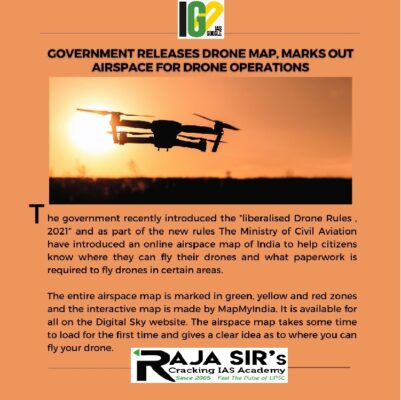
- The drone airspace map is available on DGCA’s digital sky platform to all without any login requirements.
Drone airspace map:
- The drone airspace map is an interactive map of India that demarcates the yellow and red zones across the country.
Green zone:
- Airspace upto 400 feet that has not been designated as a red or yellow zone; and upto 200 feet above the area located between 8-12 km from the perimeter of an operational airport.
- In green zones, no permission whatsoever is required for operating drones with an all-up weight upto 500 kg.
Yellow zone:
- Airspace above 400 feet in a designated green zone; above 200 feet in the area located between 8-12 km from the perimeter of an operational airport and above ground in the area located between 5-8 km from the perimeter of an operational airport.
- Permission from the concerned air traffic control authority – AAI, IAF, Navy, HAL etc. is required.
- Reduced from 45 km earlier to 12 km from the airport perimeter.
Red zone:
- ‘No-drone zone’ within which drones can be operated only after a permission from the Central Government.
THE PRESIDENT OF INDIA HAS PRESENTED THE NATIONAL SERVICE SCHEME AWARDS FOR THE YEAR 2019-20.
National Service Scheme Awards:
- The NSS awards were instituted by the Ministry of Youth Affairs & Sports in 1993-94 on the occasion of Silver Jubilee Year of National Service Scheme.
- National Service Scheme was established in 1969, on the occasion of the birth centenary of Mahatma Gandhi.
- Aim: To recognise and reward outstanding contributions towards voluntary community service made by the Universities/ Colleges, (+2) Councils and Senior Secondary, NSS Units/ Programme Officers and NSS Volunteers.
- The awards are given in three different categories like University/ +2 Councils, NSS Units and their Programme Officers and NSS volunteers.
AN INSTITUTION’S RIGHT TO GOVT. AID IS NOT A FUNDAMENTAL RIGHT: SC
According to the Supreme Court, the right of an institution, whether run by a majority or minority community to get government aid is not a fundamental right.
- Both have to equally follow the rules and conditions of the aid.
Highlights:
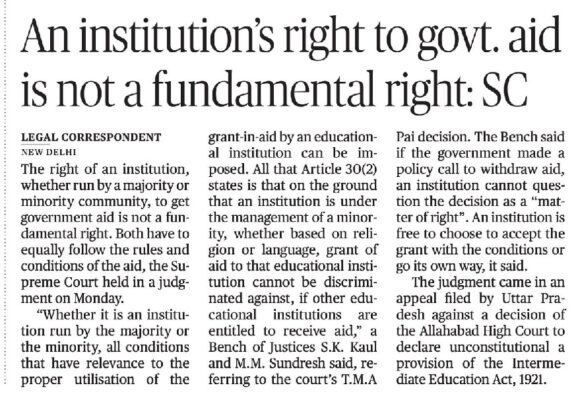
- Article 30(2) Sates that, an institution is under the minority, whether based on religion or language, grant of aid to that educational institution cannot be discriminated against, if other educational institutions are entitled to receive aid.
- If the government made a policy call to withdraw aid, an institution cannot question the decision as a “matter of right”.
- A grant of government aid comes with accompanying conditions. An institution is free to choose to accept the grant with the conditions or go its own way.
- An institution can never be allowed to say that the grant of aid should be on its own terms.
Why institutions cannot do so?
- Government aid is a policy decision. It depends on factors including the interests of the institution and the ability of the government to understand the exercise.
- Financial constraints and deficiencies are the factors which are relevant in taking any decision.
- Right to get an aid is not a fundamental right, the challenge to a decision made in implementing it, shall only be on restricted grounds.
- When a policy decision is made to withdraw the aid, an institution cannot question it as a matter of right.
Article 30?
- Article 30 of the Indian Constitution states the right of minorities to establish and administer educational institutions.
- It says: “All minorities, whether based on religion or language, shall have the right to establish and administer educational institutions of their choice.”
- It was adopted on December 8, 1948.
Features:
- Article 30(1) says, all minorities whether based on religion or language, shall have the right to establish and administer educational institutions of their choice.
- Article 30(1A) deals with the fixation of the amount for acquisition of property of any educational institution established by minority groups.
Article 30(2) states that, the government should not discriminate against any educational institution on the ground that it is under the management of a minority, whether based on religion or language, while giving aid.
PM MODI LAUNCHES AYUSHMAN BHARAT DIGITAL MISSION, SAYS WILL BRING REVOLUTIONARY CHANGES IN HEALTH FACILITIES
The Prime Minister launched the Ayushman Bharat Digital Mission on 27th September 2021, to bring revolutionary changes in the health facilities.
Highlights:
- The initiative would play a big role in eliminating problems in medical treatment of the poor and middle class.
- It will connect patients with hospitals across the nation and provide a strong technology platform.
- It will provide reliable data, leading to better treatment and savings for patients.
Ayushman Bharat Digital Mission:
- A unique digital health ID will be provided to the people, which will contain all the health records of the person.
- It will enable access and exchange of longitudinal health records of citizens with their consent.
- Includes a health ID for every citizen that will work as their health account, to which personal health records can be linked and viewed with the help of a mobile application.
- Healthcare Professionals Registry (HPR) and Healthcare Facilities Registries (HFR) will act as a repository of all healthcare providers.
- It will ensure ease of doing business for doctors and hospitals and healthcare service providers.
- It will create integration within the digital health ecosystem, like the Unified Payments Interface (UPI).
Key Facts:
- The pilot project of the National Digital Health Mission was announced by the Prime Minister during Independence Day from the Red Fort on August 15, 2020.
- At present, the project is implemented in the pilot phase in six Union Territories.
SWACHH SURVEKSHAN 2022 LAUNCHED WITH ‘PEOPLE FIRST’ AT ITS CORE
Ministry of Housing and Urban Affairs launched the seventh consecutive edition of Swachh Survekshan, at New Delhi on 27th September 2021.
Highlights:
- It focusses on the initiatives of cities for the welfare and well-being of frontline sanitation workers.
- It will reinforce the participation of senior citizens and young adults towards upholding the cleanliness of urban India.
Swachh Survekshan 2022:
- It is the 7th consecutive edition of Swachh Survekshan, conducted by Swachh Bharat Mission-Urban (SBM-U).
- It will boost the Swachh Bharat Mission towards a circular economy approach through optimum resource recovery.
- The revamped version of the Swachhata App was launched.
- It is the digital sanitation grievance redressal platform that was launched in 2016.
Theme:
- With the theme of ‘People First’, Swachh Bharat Mission-Urban (SBM-U) will organize a series of citizen-centric activities under the overarching theme of ‘Jan Bhagidari’.
- Campaigns like ‘Kachra Alag Karo’ will aim to reinforce the practice of source segregation for effective waste management.
Keys:
- Survekshan 2021 will create a level playing field for smaller cities by introducing two population categories, one under 15,000 and another between 15,000-25,000.
- District rankings have been introduced to expand the Survekshan footprint.
- It will now cover 100% wards for sampling, as compared to 40% in previous years.
- Increase in the number of assessors for the on-field assessment.
- The survey will have improved technological interventions such as
- QR code-based citizens’ feedback, geo-tagging of sanitation, waste management for better efficiency, and digital tracking of documents.
CCI SLAPS RS 873 CRORE FINE ON UBL, CARLSBERG, OTHERS FOR ‘CARTELISATION’ OF BEER SALE
Competition Commission of India slapped a penalty of Rs 873 crore on the companies as well as the All-India Brewers Association and 11 individuals for cartelization in the sale and supply of beer in 10 states and Union Territories.
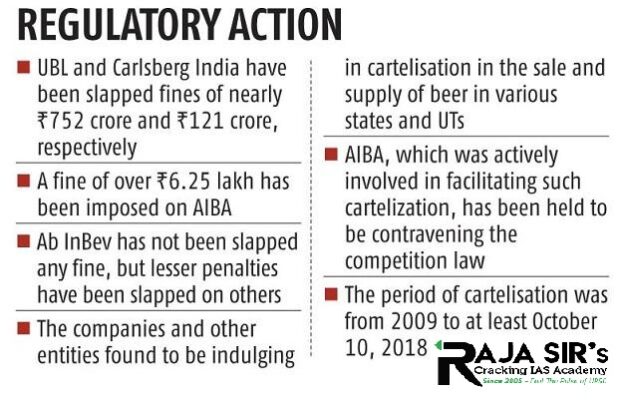
- United Breweries Ltd (UBL), Carlsberg India Pvt Ltd (CIPL) and Anheuser Busch InBev India, had colluded to fix beer prices between 2009 and 2018.
What Is a Cartel?
- A cartel is an organization created from a formal agreement between a group of producers of a good or service to regulate supply in order to regulate prices.
- It is a collection of independent businesses or countries that act together as if they were a single producer and thus can fix prices for the goods they produce and the services they render, without competition.
Key Points:
- Cartels are competitors in the same industry and seek to reduce that competition by controlling the price in agreement with one another.
- Strategy used by cartels include reduction of supply, price-fixing, collusive bidding, and market carving.
- In most regions, cartels are considered illegal and promoters of anti-competitive practices.
- The actions of cartels hurt consumers primarily through increased prices and lack of transparency.
How Cartel can be worse than Monopoly?
- Cartels could extract a higher social cost than even monopolies.
- Monopolies are a source of social loss through productive inefficiencies. The reduced product innovation, is a greater problem with cartels than monopolies.
- Given that innovation would require the expenditure of research and development costs, such investment would not be undertaken.
- Since the monopolist, unlike the cartelist, must be concerned with other firms developing goods which may be less expensive substitutes for its goods,
- The monopolist may have greater incentive for research and development expenditure.
- Thus, the social costs of reduced product innovation may be greater with cartels.
- Cartels neither have any incentive to invest in research aimed at improving their product nor do they see any reason why they should boost investments towards making the methods of production more efficient.
Competition Commission of India:
- The Competition Commission of India was established in 2003.
- Aim: To establish a competitive environment in the economy through engagement with the stakeholders, government, and international jurisdiction.
Objectives:
- To prevent practices that harm the competition.
- To promote and sustain competition in markets.
- To protect the interests of consumers.
- To ensure freedom of trade.
Formation of the Commission:
- The CCI was established under the provisions of the Competition Act 2002.
- The Competition (Amendment) Act, 2007 was enacted to amend the Competition Act, 2002.
- This led to the establishment of the CCI and the Competition Appellate Tribunal.
Functions of the Commission:
- Ensuring the benefit and welfare of the customers are maintained in the Indian Market.
- Inclusive economic growth through fair and healthy competition in the economic activities of the nation.
- Efficient utilization of the resources through the execution of competition policies.
- It is the antitrust ombudsman for small organizations.
- It scrutinizes any foreign company that enters the Indian market through a merger or acquisition to ensure that it abides by India’s competition Act 2002.
- It ensures interaction and cooperation with the other regulating authorities in the economy.
AKASH PRIME, THE NEW VERSION OF AKASH MISSILE, SUCCESSFULLY TESTED IN ODISHA
A new version of the Akash Missile – ‘Akash Prime’ has been successfully flight tested from Integrated Test Range, Chandipur, Odisha on 27 September 2021.
Highlights:

- The missile intercepted and destroyed an unmanned aerial target mimicking enemy aircrafts.
- It is equipped with an indigenous active Radio Frequency (RF) seeker for improved accuracy.
- It will ensure reliable performance under low temperature environments at higher altitudes.
- Modified ground system of the existing Akash weapon system has been used for the current flight test.
- Radars, Electro Optical Tracking System and Telemetry stations monitored the missile trajectory and flight parameters.
Akash Missile System:
- Akash is a medium-range mobile surface-to-air missile (SAM) system developed by the Defence Research and Development Organisation (DRDO).
- It can target aircraft up to 50–80 km away, at altitudes up to 18,000 m.
- It has the capability to neutralize aerial targets like fighter jets, cruise missiles and air-to-surface missiles as well as ballistic missiles.
- It can simultaneously engage Multiple Targets in Group or Autonomous Mode.
- It is operational in service with the Indian Army and the Indian Air Force.
History:
- Mark-I
- The first test flight of Akash missile was conducted in 1990.
- 3-D Central Acquisition Radar (3D-CAR) group mode performance is fully established.
- It has unique characteristics like mobility, multiple target handling, digitally-coded command guidance and fully automatic operation.
- Akash-1S
- DRDO tested Akash-1S on 25 May and 27 May 2019 with a strike range of 30 km, from Integrated Test Range (ITR), Chandipur, Odisha.
- It was fired five times against multiple targets and successfully completed the trials.
- It supports the command and active terminal seeker guidance to enhance the single shot kill probability.
- Akash-NG
- It was approved in September 2016 to succeed Akash and Akash-1S with improved capabilities.
- It has an improved reaction time and higher level of protection against saturation attacks.
- The range increased from 40 km to greater than 80 km.
INDIA GETS FIRST HERBICIDE-TOLERANT & NON-GM RICE VARIETIES
The Indian Agricultural Research Institute has developed the country’s first-ever non-genetically modified, herbicide-tolerant rice varieties.
Highlights:
- Pusa Basmati 1979 and Pusa Basmati 1985 contain a mutated acetolactate synthase (ALS) gene making it possible for farmers to spray Imazethapyr, an herbicide, to control weeds.
- The new varieties will replace water with Imazethapyr.
- There is no need for nursery, puddling, transplanting, and flooding of fields, one can sow paddy directly, just like wheat.
- The new basmati varieties contain an ALS gene whose DNA sequence has been altered using ethyl methane sulfonate, a chemical mutant.
- The plants can “tolerate” application of the herbicide, and hence it kills only the weeds.
- Both varieties have been bred by crossing, Pusa 1121 and Pusa 1509, with ‘Robin’. The latter is a mutant line derived from Nagina 22, an upland drought-tolerant rice variety.
Direct Seeding of Rice Technique:
- Farmers in Punjab and Haryana are adopting direct seeding of rice (DSR) in response to labour shortages and depleting water tables.
- DSR cultivation is based on two herbicides, Pendimethalin and Bispyribac-sodium. These are costlier than Imazethapyr.
- Imazethapyr, has a wider weed-control range and is safer, as the ALS gene isn’t present in humans and mammals.
- DSR need 30 per cent less water, it will save Rs 3,000 per acre in transplantation labour charges,
- It will reduce the time due to no nursery preparation.
ASSAM’S RICE WINE JUDIMA GETS GI TAG
Judima, the wine brewed by the Dimasa community in Assam, has been awarded the geographical indication (GI) tag.
Highlights:
- The wine made from rice and a certain herb is the first beverage from the north-east to earn the label.
- The Assam Agricultural University, coordinated the research on the popular drink with the Youth Association for Development and Empowerment (YADEM) in Assam’s Dima Hasao district.
- Judima is intrinsic to the social and cultural life of the Dimasas.
- The GI tag for the drink came 14 years after the ginger of the adjoining Karbi Anglong district received its geographical indication.
UNION INFORMATION & BROADCASTING MINISTER INSPECTED THE ZOJILA AND Z -MORH TUNNEL PROJECTS IN THE UNION TERRITORY OF JAMMU AND KASHMIR.
Highlights:

- Zojila Tunnel is of a significant importance about national security, development and tourism for J&K and Ladakh Union Territories.
- The project site of Zojila tunnel is being constructed at the cost of 4500 crore rupees.
- It is located at the national highway (NH-01) starting from Sanamarg in J&K and ending at Minamarg in Ladakh.
- The Tunnel will promote the Tourism Sector of Ladakh and Jammu & Kashmir Union territories besides ensuring all-weather connectivity.
- The minister laid the foundation stone for the development of playfield at Kijpora in Kangan area.
- He Inaugurated Bonibagh-Kangan road constructed under Pradhan Mantri Gram Sadak Yojna.
Next
previous









































 Latest News
Latest News
 General Studies
General Studies